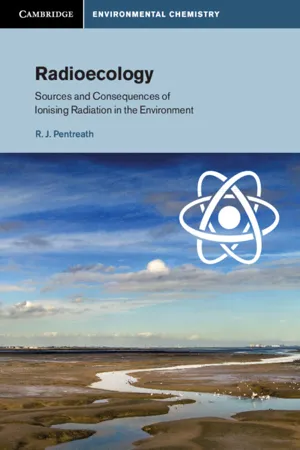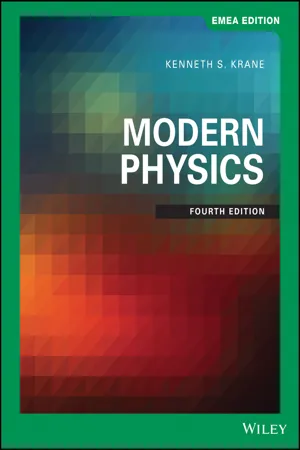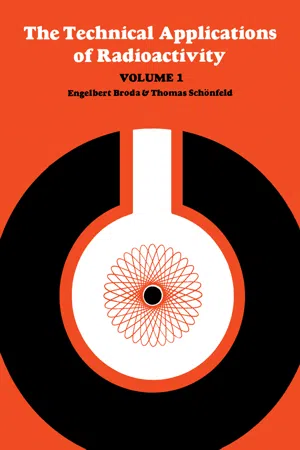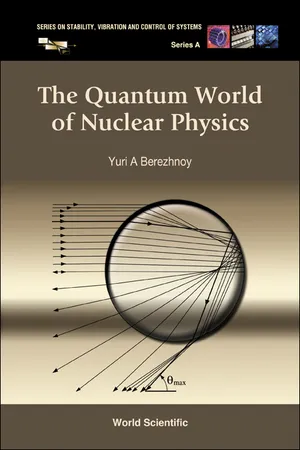Physics
Atoms and Radioactivity
Atoms are the basic building blocks of matter, composed of a nucleus containing protons and neutrons, surrounded by electrons. Radioactivity is the spontaneous emission of radiation from the nucleus of an unstable atom, often resulting in the transformation of the atom into a different element. This process can release energy in the form of alpha, beta, or gamma radiation.
Written by Perlego with AI-assistance
Related key terms
1 of 5
11 Key excerpts on "Atoms and Radioactivity"
- eBook - PDF
Radioecology
Sources and Consequences of Ionising Radiation in the Environment
- R. J. Pentreath(Author)
- 2021(Publication Date)
- Cambridge University Press(Publisher)
Where more than one stable nuclide occurs, they are not equally abundant. In the case of hydrogen, for example, 99.985% are 1 H, the remaining 0.015% being 2 H. Tin, however, consists of 10 nuclides, the most abundant being 120 Sn (32.4%), 118 Sn (24.3%), and 116 Sn (14.7%) [1]. Some atomic nuclei are, or may be induced to become, unstable. Indeed, as the structure of the atom emerged from scientific observation it was conceptually difficult to understand how it had any stability at all, given that the positively charged protons at such close proximity within the nucleus of an atom should, on the understanding of physics at that time, repel each other and cause the nucleus to fall apart. To further complicate matters, it also became clear that the neutrons and protons were able to change from one to the other. It is now known that unstable nuclei disintegrate in a number of ways, and that their disintegration is always accompanied by the emission of some form of radiation. Such unstable nuclides are therefore known either as radioisotopes or by the almost synonymous term, radio- nuclide, when discussing a particular type of atom in a specific energy state. (And, again, this is the term that will mainly be used in the following chapters.) Such atoms, or the materials containing them, are therefore said to be radioactive, and the term used to describe this physical rather than chemical property of such atomic nuclei is radioactivity. Radioactivity is thus, as Becquerel had observed and as the term, coined by the Curies indicates, simply a phenomenon. But it is a phenomenon that has taken a long time to resolve, and in order to describe it one has to consider, briefly, something about the fundamental nature of forces and particles, which we are fortunately able to do thanks to what is currently known as the Standard Model. 2.2 Elementary Particles and Their Interactions So what is radioactivity, in a physical sense? Well, we now have a much better idea. - eBook - PDF
Isotopes in Nanoparticles
Fundamentals and Applications
- Jordi Llop, Vanessa Gomez-Vallejo, Jordi Llop, Vanessa Gomez-Vallejo(Authors)
- 2016(Publication Date)
- Jenny Stanford Publishing(Publisher)
Although the concepts in this chapter are readily found in other books, scientific journals, or online, the inclusion of a short overview of the main aspects of radioactive decay and its implications for labelled NPs remains appropriate. In addition, by the end of the chapter, the reader should be able to answer the three questions posed above. 6.2 Radioactivity and Radioactive Decay 6.2.1 The (Radioactive) Atom Matter is composed of elements, and all elements are composed of atoms. Atoms can be defined as the smallest unit of an element having all the characteristics of that element . Contrary to the original idea when the term “atom” was coined (from the Greek atomos , indivisible), the atom is not the smallest physical unit and it contains sub-atomic particles. Consider this very simple model: an atom contains a very small nucleus consisting of protons and neutrons with electrons revolving in orbits around the nucleus. Electrons are negatively charged, protons are positively charged, and neutrons have no electrical charge. The number of protons defines the element (e.g. one atom with one proton in the nucleus is always hydrogen, one atom with nine protons in the nucleus is always fluorine), while the number of neutrons defines the different isotopes of a given element. For instance, there are three hydrogen isotopes, namely hydrogen, deuterium, and tritium; all contain one proton, but they have zero, one, and two neutrons in their nuclei, respectively. The nucleus contains forces that keep the neutrons and protons together. If these forces are balanced, the atom is stable; if these forces are not balanced, the atom is unstable. In the latter state, the nucleus has an excess of internal energy and tends to move to a more stable state. The process by which the atomic nucleus moves from an unstable to a more stable state is called radioactive decay. Radioactive decay is spontaneous and is accompanied by the emission of particles and/or electromagnetic radiation. - eBook - PDF
Isotopic Tracers in Biology
An Introduction to Tracer Methodology
- Martin D. Kamen, Louis F. Fieser, Mary Fieser(Authors)
- 2013(Publication Date)
- Academic Press(Publisher)
CHAPTER I ATOMIC NUCLEI, RADIOACTIVITY, AND THE PRODUCTION OF RADIOACTIVE ISOTOPES 1 . INTRODUCTORY REMARKS The application of tracer procedures to biological problems does not depend on detailed knowledge of the physical background of tracer meth-odology. However, most research workers and students who work with tracers want basic information about the nature of tracers and the funda-mentals of atomic and nuclear physics. The introductory chapters of this book are written with this in mind. The following brief discussion of fact and theory about atoms and nuclei can be elaborated by reference to the bibliography included in the text. 2. GENERAL PROPERTIES OF NUCLEI A. N U C L E A R S T R U C T U R E All elements are made up of small ultimate units or atoms. Atoms con-tain a positively charged nucleus (radius <10~ 1 2 cm.) which, although it comprises a very small fraction of the atomic volume (radius ~ 1 0 ~ 8 cm.), accounts for practically all the weight of the atom. Most of the atomic volume can be said to be relatively i 'empty, being occupied by negatively charged electrons, which are many thousandfold lighter than the nuclear particles. Nuclear matter, in other words, is enormously more dense than atomic matter; its density approximates 10 8 tons per cubic centimeter. Such fantastic densities imply forces of a type not encountered in common ex-perience. It is necessary to suppose that enormous attractive forces spring into being when matter is compressed to form atomic nuclei. Present knowledge holds that nuclei consist of particles called neutrons and protons, for which the collective term is nucléons. Nuclei are built up by addition of approximately equal quantities of neutrons and protons, beginning with the lightest nucleus, that of the ordinary hydrogen atom. The nucleus of hydrogen is nothing more than a single proton. Protons and neutrons differ in that protons carry a unit positive electric charge (4.8025 X 10~ 10 electrostatic unit). - eBook - PDF
The Sciences
An Integrated Approach
- James Trefil, Robert M. Hazen(Authors)
- 2022(Publication Date)
- Wiley(Publisher)
But some kinds of atomic nuclei are not sta- ble. Uranium-238, for example, which is the most common isotope of the rather common element uranium, has 92 protons and 146 neutrons in its nucleus. If you put a block of uranium-238 on a table in front of you and watched for a while, you would find that a few of the uranium nuclei in that block would disintegrate spontaneously. One moment there would be a normal uranium atom in the block, and the next moment there would a couple of smaller atoms, a few fast moving particles, and no uranium. At the same time, fast-moving particles would speed away from the uranium block into the surrounding environment. This spontaneous release of energetic particles is called radioactivity or radioactive decay (Figure 12.3).The emitted particles themselves are referred to as radi- ation. The term radiation used in this sense is somewhat different from the electromagnetic radiation that we introduced in Chapter 6. In this case, radiation refers to whatever comes out from the spontaneous decay of nuclei, be it electromagnetic waves or actual particles with mass. THINK! STOP & What might the world be like if most atoms were radioactive? What Is Radioactive? Almost all of the atoms around you are stable, but most everyday elements have at least a few isotopes that are radioactive. Carbon, for example, is stable in its most common iso- topes, carbon-12 and carbon-13; but carbon-14, which constitutes about a trillionth of the carbon atoms in living things, is radioactive. A few elements such as uranium, radium, and thorium have no stable isotopes at all. Even though most of our surroundings are composed of stable isotopes, a quick glance at the chart of isotopes (Figure 12.2) reveals that most of the 2,000 or so known natural and laboratory-produced isotopes are unstable and undergo radioactive decay of one kind or another. - eBook - PDF
- Kenneth S. Krane(Author)
- 2020(Publication Date)
- Wiley(Publisher)
Chapter 12 NUCLEAR STRUCTURE AND RADIOACTIVITY Radioactive isotopes have proven to be valuable tools for medical diagnosis. The photo shows gamma-ray emission from a patient who has been treated with a radioactive element. The radioactivity concentrates in locations where there are active cancer tumors, which show as bright areas in the gamma-ray scan. This patient’s cancer has spread from his prostate gland to several other locations in his body. GJLP, CNRI / Science Source 390 Chapter 12 Nuclear Structure and Radioactivity The nucleus lies at the center of the atom, occupying only 10 −15 of its vol- ume but providing the electrical force that holds the atom together. Within the nucleus there are Z positive charges. To keep these charges from flying apart, the nuclear force must supply an attraction that overcomes their electrical repulsion. This nuclear force is the strongest of the known forces; it provides nuclear binding energies that are millions of times stronger than atomic bind- ing energies. There are many similarities between atomic structure and nuclear structure, which will make our study of the properties of the nucleus somewhat famil- iar. Nuclei are subject to the laws of quantum physics. They have ground and excited states and emit photons in transitions between the excited states. Just like atomic states, nuclear states can be labeled by their angular momentum. There are, however, two major differences between the study of atomic and nuclear properties. In atomic physics, the electrons experience the force provided by an external agent, the nucleus; in nuclear physics, there is no such external agent. - eBook - PDF
- B. Zemel(Author)
- 1995(Publication Date)
- Elsevier Science(Publisher)
Radioactivity Basics RADIOACTIVITY Some combinations of protons and neutrons result in unstable nuclei. Such nuclides undergo spontaneous disintegration with time. This decay, accompanied by the emission of nuclear particles and/or electromagnetic radiation, is termed radioactivity. Emission of particles from the nucleus also results in the formation of a new nuclide if there is a net change in the number of protons in the new nucleus as a result of the decay. Statistically, decay of a given radioactive nucleus is a random, unpredictable event; however if a sufficient number of radioactive nuclides is present, the rate of decay, dN/dT, becomes proportional to the number of nuclides (N) present. The greater the number of radioactive nuclides, the more closely this rule is followed. The rate of decay per unit time, dN/dt, is a measure of the amount of radio- activity (A) present and has the dimensions of events per second. This is shown below, where k is a proportionality constant, known as the decay constant, which is specific to each isotope. dN A= -d-~-= LN (1.2) Activity and half-life In modern (SI) nomenclature, the basic unit for the amount of radioactivity present, A, is the becquerel (Bq), which is equal to a decay rate of one disin- tegration per second (dps). An older unit still widely used in the industry is the curie (Ci), which is equal to 3.7 x 1010 dps. The Bq and the Ci are normally used in multiples and submultiples, respectively, of these units as can be seen in Table 1.2. TABLE 1.2 Unit multipliers Prefix Symbol Multiple Example femto f 10-15 fj = femtojoule pico p 10 -12 pCi = picocurie nano n 10-9 nCi = nanocurie micro ~t 10-6 ~tSv = microsievert milli m 10-3 mGy = milligray kilo k 103 kr = kilorad mega M 106 MBq = megabecquerel giga G 109 GeV = gigaelectron volt tera T 1012 TBq = terabecquerels - eBook - PDF
- Engelbert Broda, Thomas Schönfeld(Authors)
- 2013(Publication Date)
- Pergamon(Publisher)
On the one hand, there are spontaneous decompositions of unstable nuclei, which we call radioactive disintegrations. On the other hand, artificial transformations of stable or unstable atomic nuclei may be brought about through bombardment with elementary particles, with other nuclei, or with quanta of electromagnetic radiation of high energy. The manner and the velocity of the decay, if any, of an atomic nucleus depends on its composition and energy state. Among the various isotopes of an element, one or more may be stable, while others may be radioactive. Thus, the phosphorus iso-tope 15 P is stable, ° 5 P is radioactive with short life, and P is radioactive with long life. Of the three hydrogen isotopes, one, tritium, is radioactive. As far as chemical behaviour is concerned, it is quite irrelevant whether an atom is radioactive or not. As long as a radioactive isotope has not in fact undergone dis-integration, it behaves in the same way as a stable isotope. This is of fundamental importance for the use of radioisotopes as tracers (radioactive indicators). Radioactivity is usually recognized by the fact that the nucleus in the course of its transformation emits one or several rays. The most important radioactive trans-formations are accompanied by the emission of oc-, ß-or y-radiation, which will now be discussed. 1 2 Fundamentals of Radioactivity 2.7. «-radiation oc-rays consist of extremely rapid, doubly-ionized positive helium ions (helions), i.e., helium atoms which have lost both their electrons, and so consist only of the bare nuclei. Such nuclei (flc-particles, ^He) contain two protons and two neutrons. Λ-decay is a characteristic property of many nuclei with high charges, i.e., nuclei containing many protons. Charges which are confined together in a small space strong-ly repel each other. This may lead to the spontaneous expulsion of charged particles. Protons are never emitted singly in such radioactive reactions, but always in the form of ^-particles. - eBook - PDF
- Yuri A Berezhnoy(Author)
- 2005(Publication Date)
- WSPC(Publisher)
Chapter 4 Radioactivity of Atomic Nuclei 4.1 The Law of Radioactive Decay Human history records but a few great scientific discoveries made acciden-tally. The discovery of the radioactivity of atomic nuclei is one of them. Radioactivity is the process of spontaneous transmutation of an unstable nucleus into another one, which is accompanied by the emission of various particles and photons. Several elementary particles can undergo radioactive decay as well. In February 1896, the physics professor Becquerel was working at the Ecole Poly technique in Paris. He studied the abilities of various crystals under sunlight to emit a penetrating radiation similar to the X-rays that had been recently discovered by Roentgen. Becquerel supposed that crys-tals under the influence of light would emit rays that could register on the photographic plates covered by black paper. A screen made out of copper wires was placed between the crystal and the plate. Thus, after developing, the plate would be light-struck everywhere except the region covered by the copper wires. Among the crystals Becquerel was working with, by chance some ura-nium salts were stored, specifically uranium sodium bisulphate. Also by chance, the weather during the experiments was cloudy so that Becquerel put the plates into the box of the laboratory table together with the crystals of uranium salt. After a few days when the plates were developed, they appeared dark and demonstrated a very clear image of the screen, even though no sunlight had illuminated the uranium salt. Becquerel attributed the rays that registered on the plate to the ura-nium. Afterwards it was found that the same rays could be emitted by other elements as well. In 1898, Marie Sklodowska-Curie discovered that 89 90 The Quantum World of Nuclear Physics the same rays were emitted by thorium; she and her husband Pierre Curie subsequently discovered radium. The term radium originates from the Latin word radius, which means ray. - eBook - PDF
Radioactive Tracers in Biology
An Introduction to Tracer Methodology
- Martin D. Kamen, Louis F. Fieser, Mary Fieser(Authors)
- 2013(Publication Date)
- Academic Press(Publisher)
CHAPTER I Atomic Nuclei, Radioactivity, and the Production of Radioactive Isotopes 1. INTRODUCTORY REMARKS The application of tracer procedures to biological problems does no depend on detailed knowledge of the physical background of trace methodology. However most research workers and students are avk for information on the basic nature of tracers and on fundamentals o atomic and nuclear physics. The introductory chapters of this bool are written with this in mind. The following brief discussion of fact and theory about atoms and nuclei can be elaborated by reference to th< bibliography included at various appropriate places in the text. 2. GENERAL PROPERTIES OF ATOMIC NUCLEI A. Nuclear Terminology Nuclear Mass. The mass of any nucleus is referred to the mass o the oxygen atom of weight 16 which is defined as having a mass exactb equal to 16.000 . . . . The mass number, symbolized by A, is the integra number nearest the actual mass. Thus the hydrogen nucleus or protoi is found to have a mass of 1.00758 compared to O 1 6 . Its mass number A is, therefore, 1. In nuclear nomenclature the mass number is usualb written as the right superscript to the chemical symbol for the atom i.e., H l , Na 2 3 , P 3 2 . Nuclear Charge. The electric charge carried by the nucleus is positive and equal numerically to the atomic number, usually symbolized by Z The atomic number is also equal to the number of extranuclear electron! in the neutral atom because, to satisfy the requirement of electric neu trality, there must be as many of these as there are positive charges oi the nucleus. The atomic number is usually written as a left subscrip to the chemical symbol, i.e., iH, nNa, i 5 P. The nucleus is completely identified if both the mass number A and the atomic number Z are indi cated; thus iH 1 , nNa 2 3 , and i B P 31 refer to certain kinds of nuclei for th< elements hydrogen, sodium, and phosphorus, respectively. - In just the same way, the particles in a nucleus can shift between dif- ferent energy levels. These shifts, or nuclear quantum leaps, involve energy differences thousands or millions of times greater than those of an atom’s electrons. When particles in a nucleus undergo shifts from higher to lower energy levels, some of the emitted gamma radiation is in the range of X-rays, while others are even more energetic. A nucleus emits gamma rays any time its protons and neutrons reshuffle. Neither the protons nor the neutrons change their identity, so the daughter atom has the same mass, the same isotope number, and the same chemical identity as the parent. Neverthe- less, this process produces highly energetic radiation. RADIATION AND HEALTH The most important thing to realize about radiation is that it is a natural part of our environment. Life on our planet evolved in a radioactive environment, and radiation did not suddenly appear when we were able to detect and mea- sure it in the twentieth century. Cosmic rays from space are passing through your body as you read this, for example. As we shall see in Chapter 25, living things evolve in such a way as to adapt to their environment. This means that cells in organisms (including humans) have, over the ages, developed mecha- nisms for repairing the damage caused by radiation. In fact, there is a long- standing debate between scientists on the question of whether or not small amounts of radiation, by stimulating the immune system, actually improve an organism’s overall health. Now that we understand what radi- ation is, we can understand how it might Figure 12-8 • The damage to atoms and molecules from different kinds of radiation can be compared to the damage to objects in an alleyway caused by different types of vehicles. The massive, lumbering truck is analogous to an alpha particle (a); the smaller, faster car is analogous to a beta particle (b); and the small, swift motorcycle is analogous to a gamma ray (c).
- eBook - PDF
- John D. Cutnell, Kenneth W. Johnson, David Young, Shane Stadler(Authors)
- 2018(Publication Date)
- Wiley(Publisher)
31.3 The Mass Defect of the Nucleus and Nuclear Binding Energy The binding energy of a nucleus is the energy required to separate the nucleus into its constituent protons and neutrons. The binding energy is given by Equation 31.3, where Δm is the mass defect of the nucleus and c is the speed of light in a vacuum. The mass defect is the amount by which the sum of the individual masses of the protons and neutrons exceeds the mass of the intact nucleus. When specifying nuclear masses, it is customary to use the atomic mass unit (u). One atomic mass unit has a mass of 1.6605 × 10 −27 kg and is equivalent to an energy of 931.5 MeV. Binding energy = (∆m) c 2 (31.3) 31.4 Radioactivity Unstable nuclei spontaneously decay by breaking apart or rearranging their internal structure in a process called radioactivity. Naturally occurring radioactivity produces α, β, and γ rays. α rays consist of positively charged particles, each particle being the 4 2 He nucleus of helium. The general form for α decay is Z A P Z−2 A−4 D + 2 4 He The most common kind of β ray consists of negatively charged particles, or β − particles, which are electrons. The general form for β − decay is Z A P Z+1 A D + −1 0 e β + decay produces another kind of β ray, which consists of positively charged particles, or β + particles. A β + particle, also called a positron, has the same mass as an electron, but carries a charge of +e instead of −e. If a radioactive parent nucleus disintegrates into a daughter nucleus that has a different atomic number, as occurs in α and β decay, one element has been converted into another element, the conversion being referred to as a transmutation. γ rays are high-energy photons emitted by a radioactive nucleus. The gen- eral form for γ decay is Z A P* Z A P + γ decay does not cause a transmutation of one element into another.
Index pages curate the most relevant extracts from our library of academic textbooks. They’ve been created using an in-house natural language model (NLM), each adding context and meaning to key research topics.










